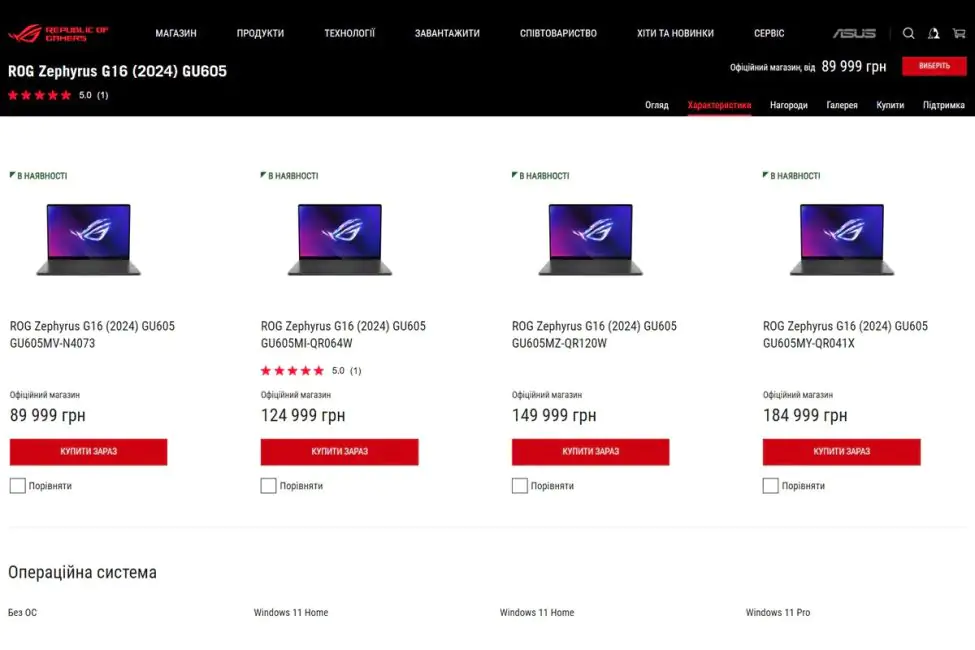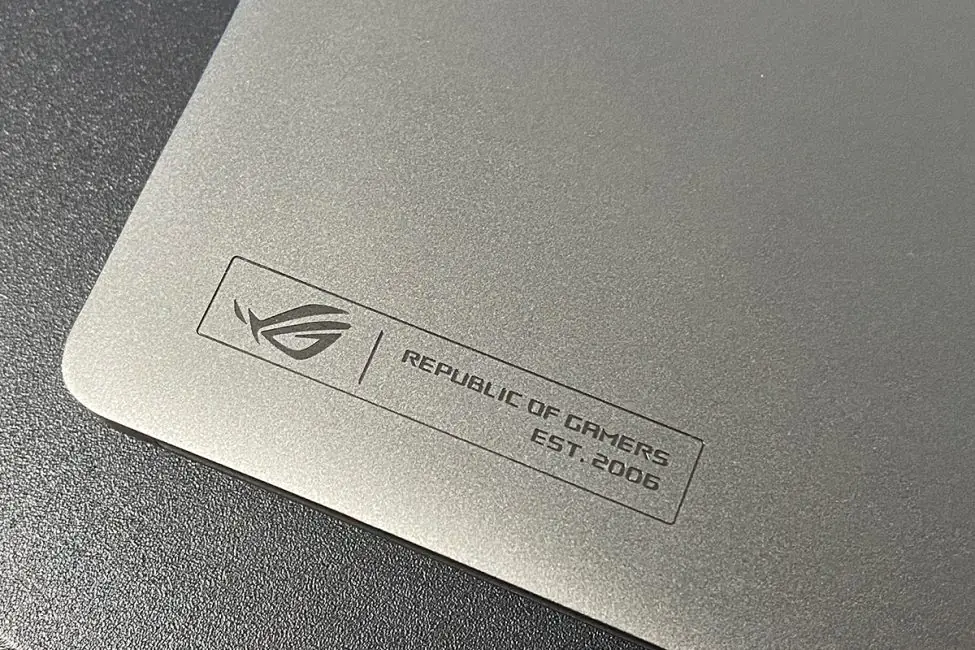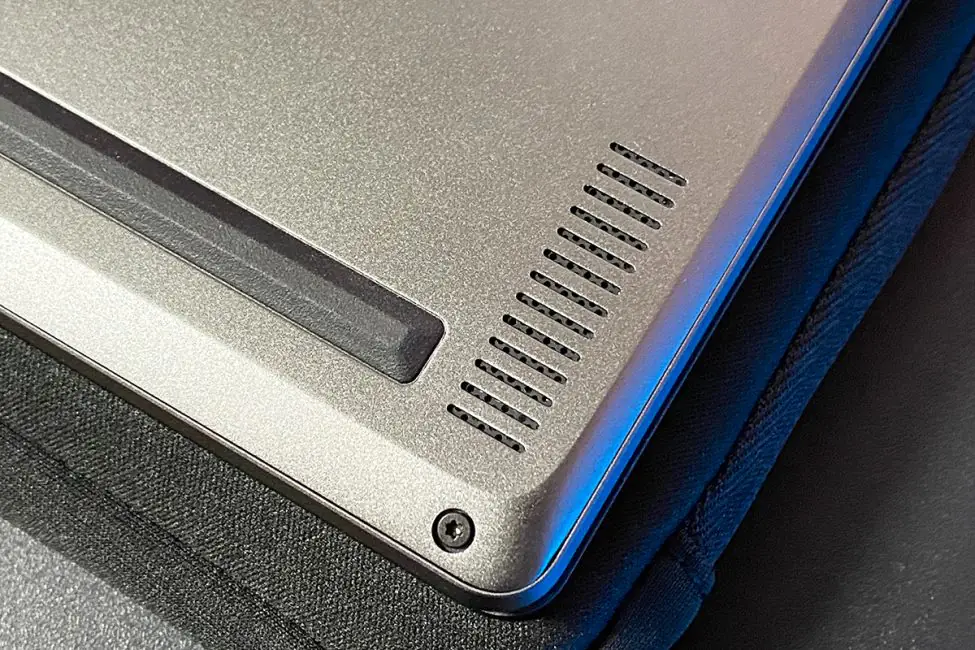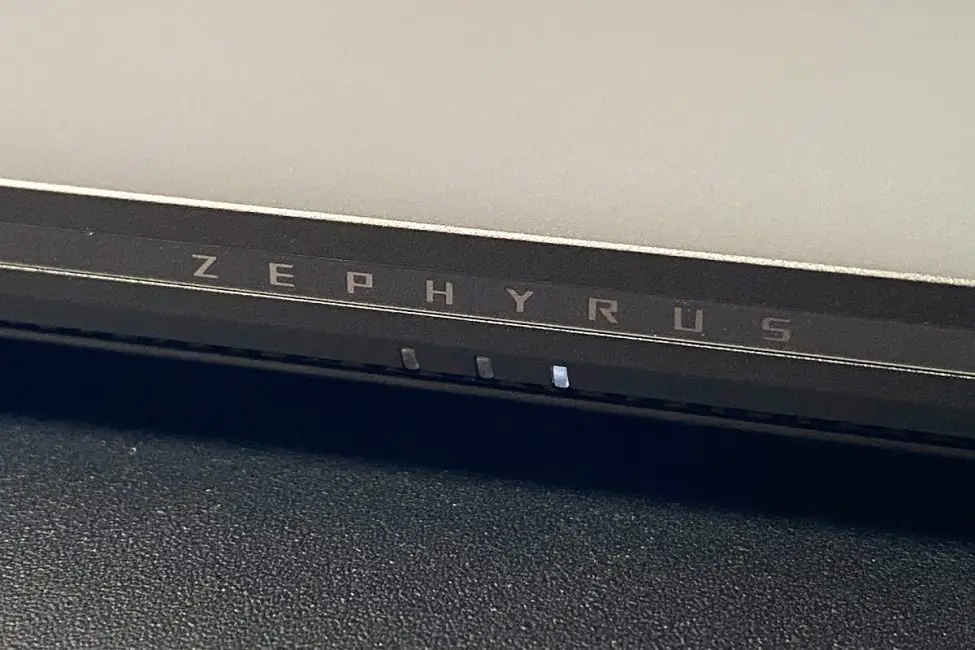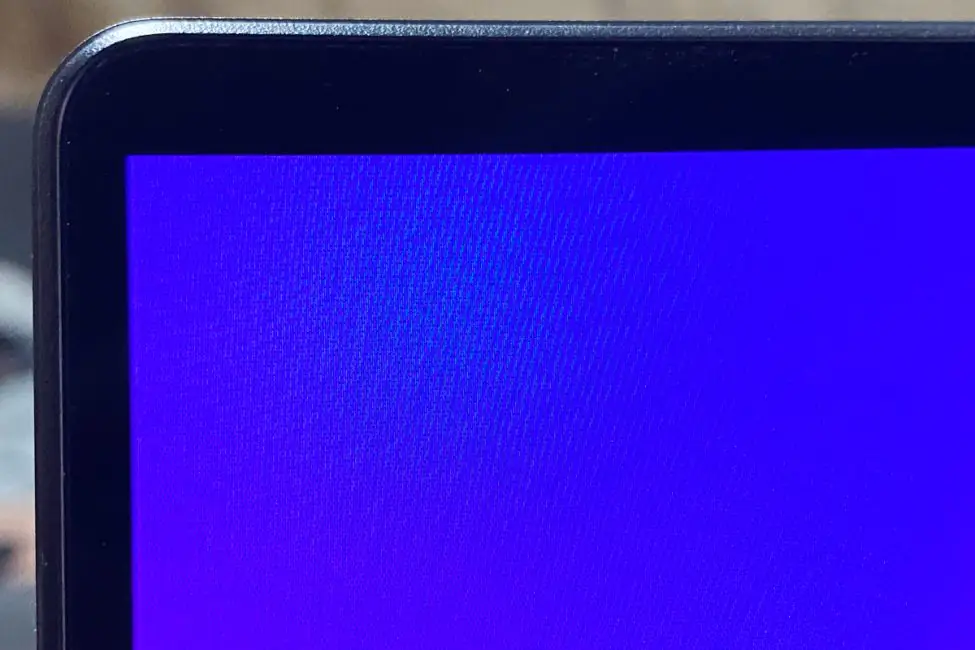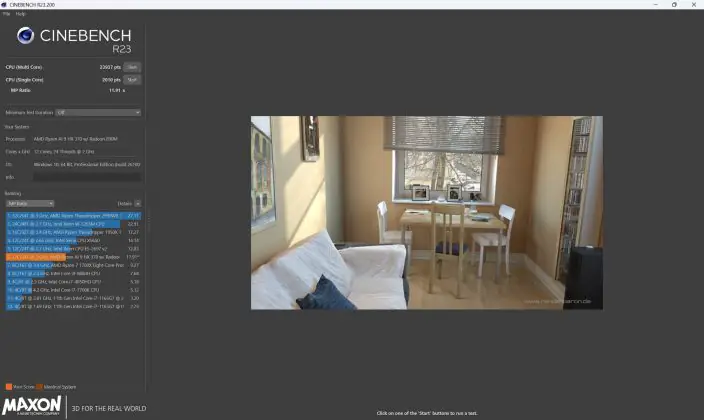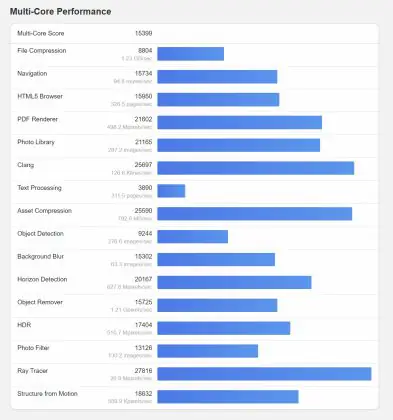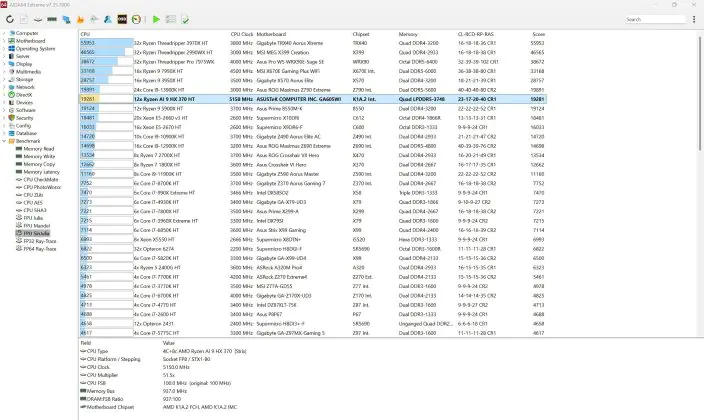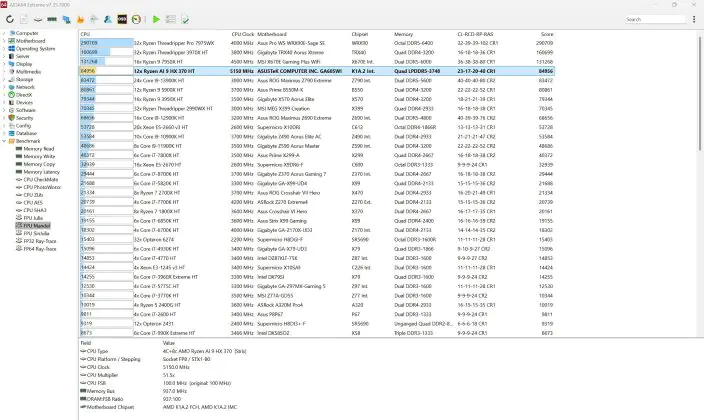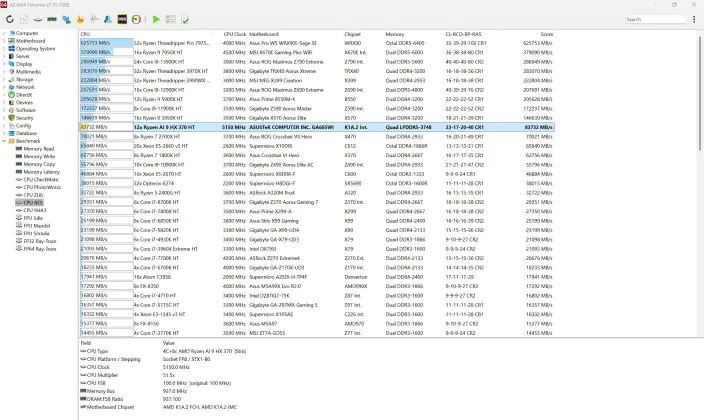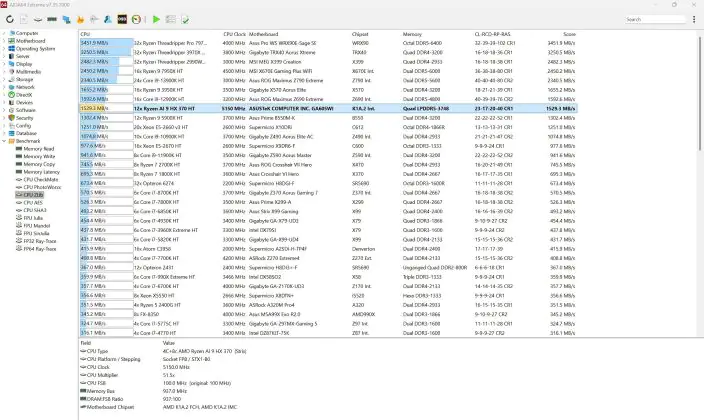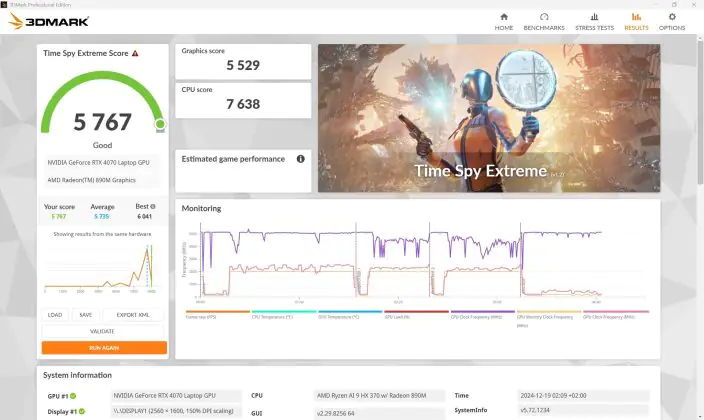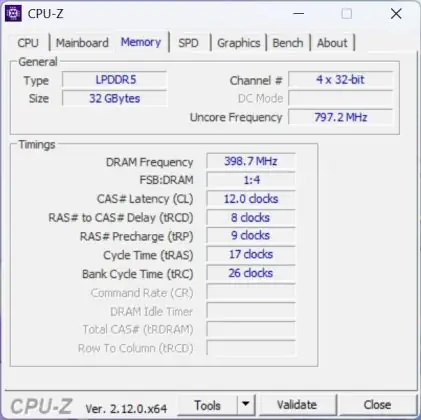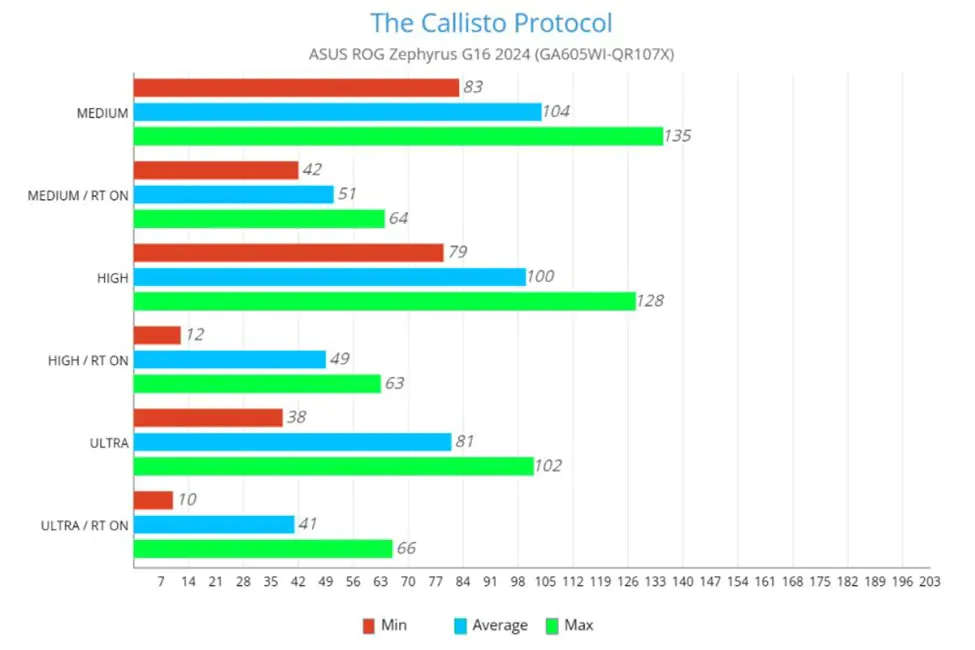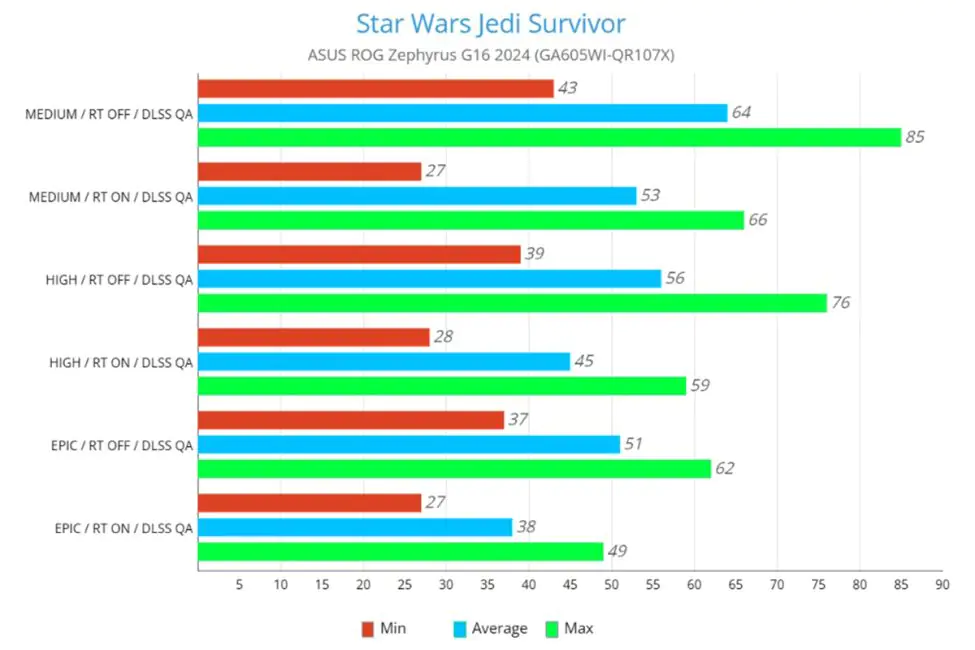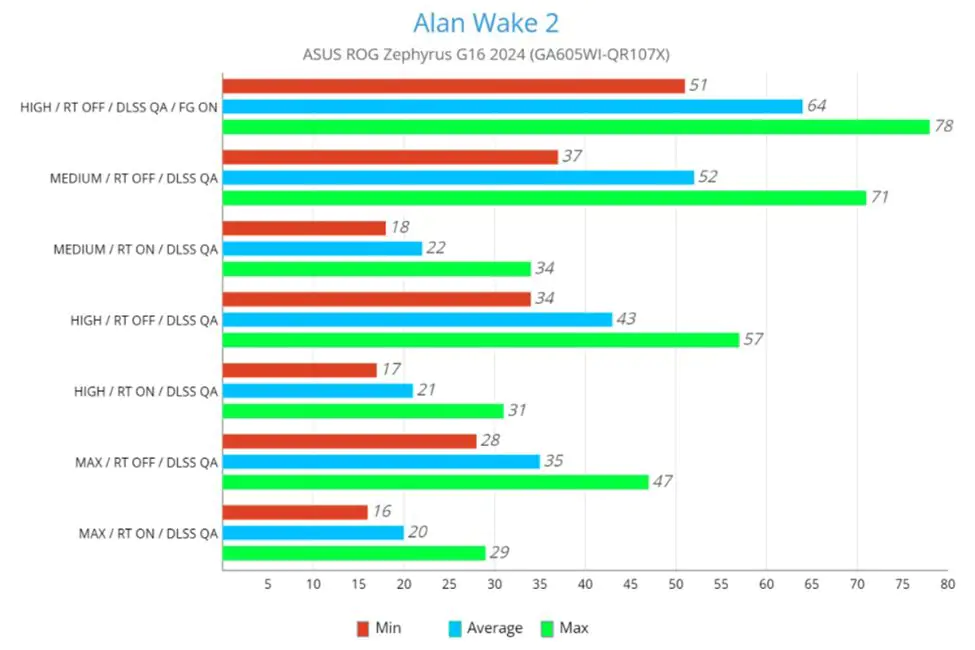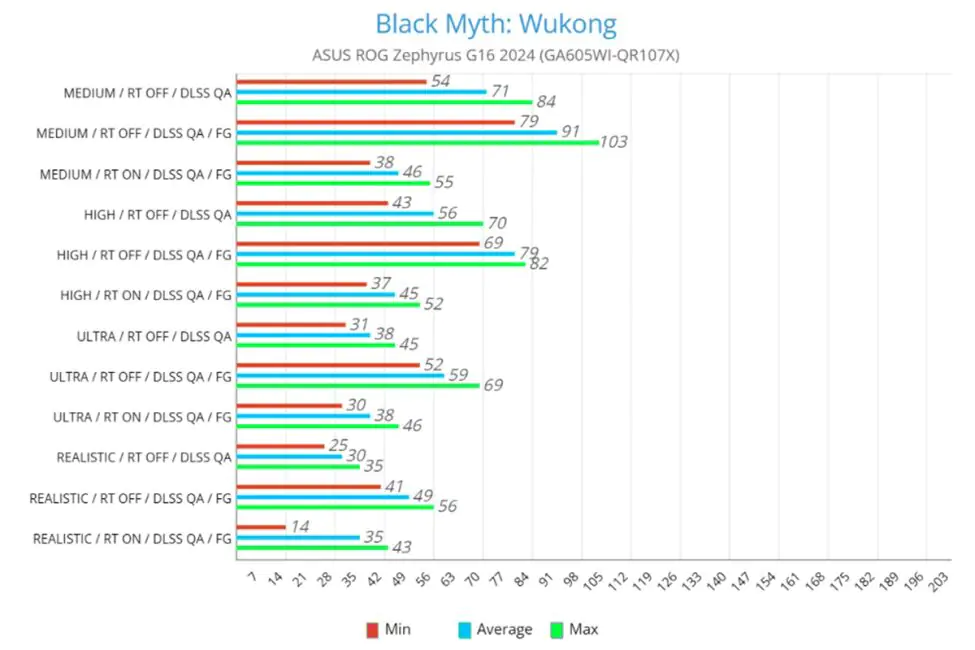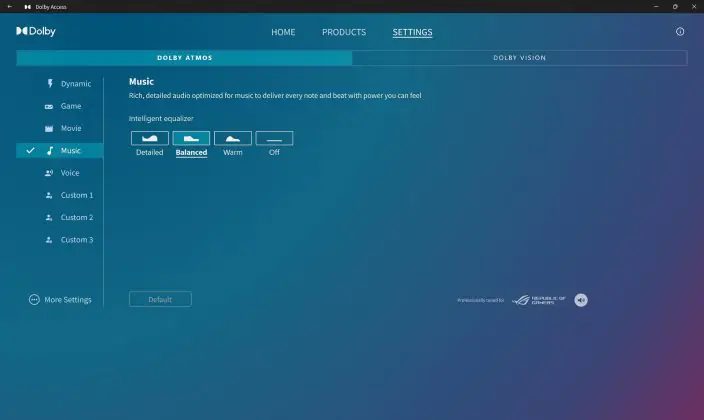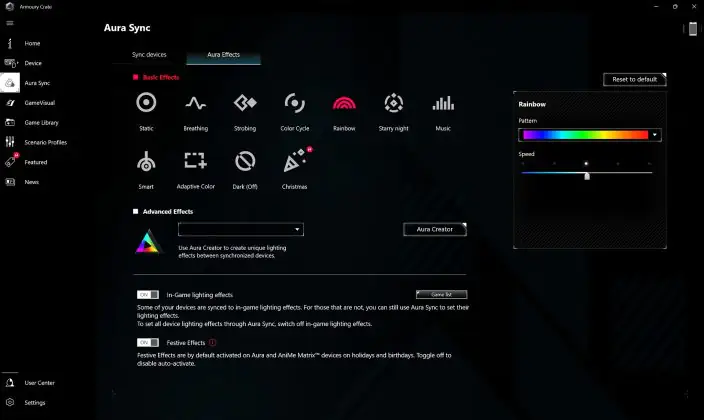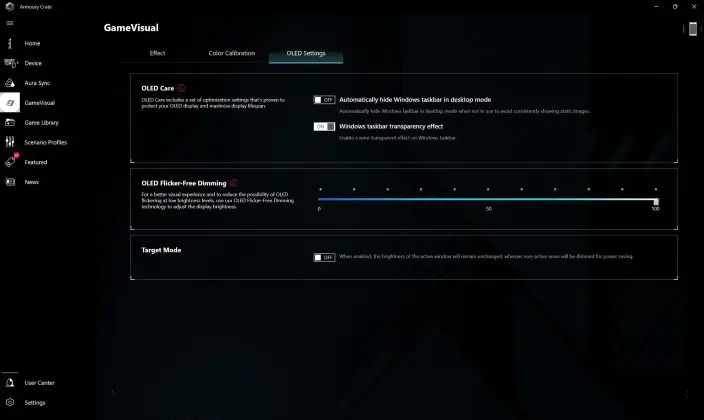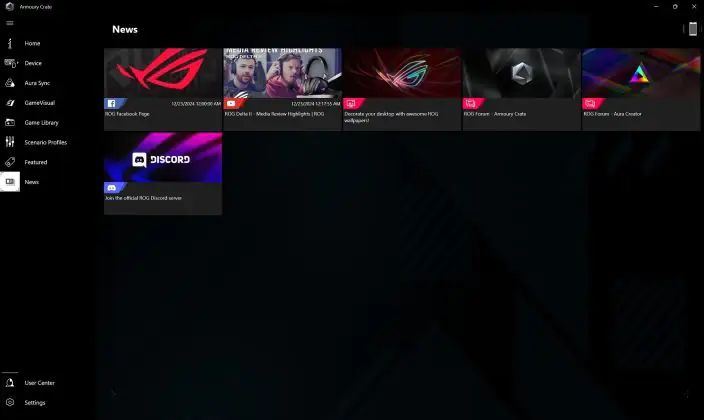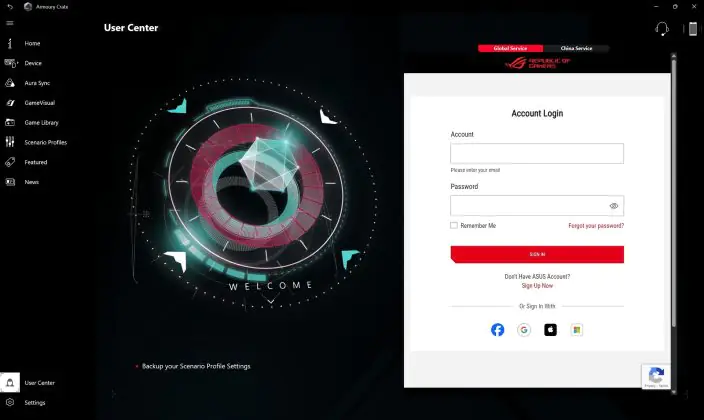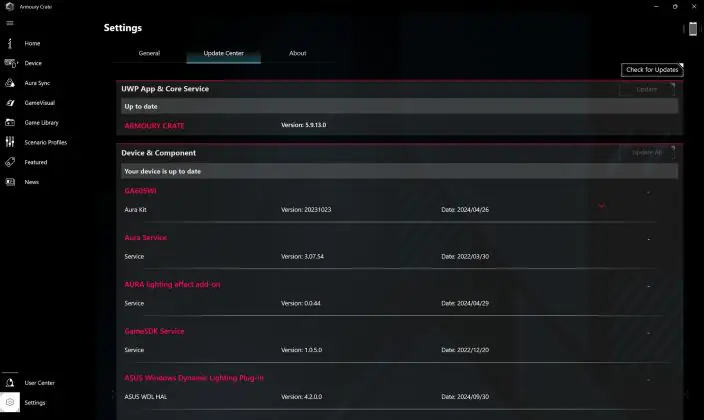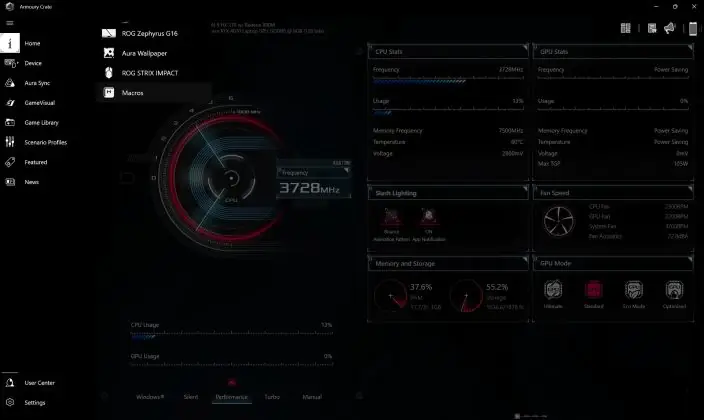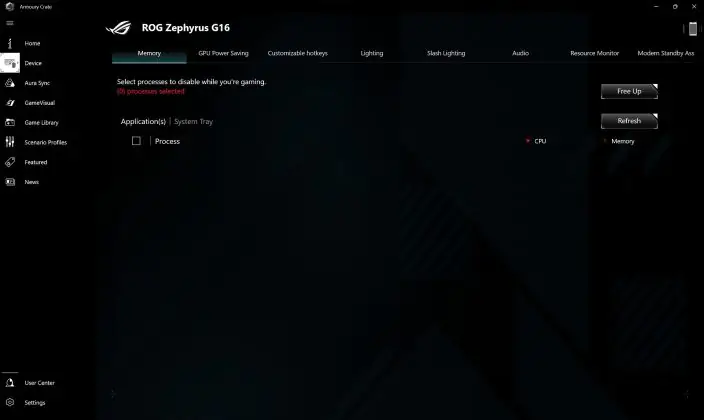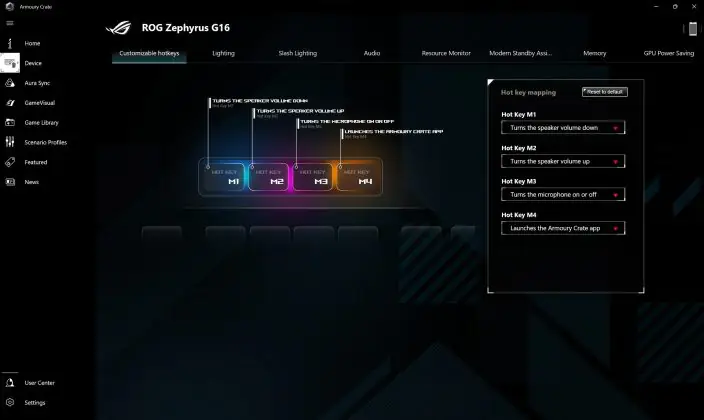© ROOT-NATION.com - Use of content is permitted with a backlink.
Recently, I reviewed the ASUS ROG Zephyrus G16 2024 (GU605MI-QR064W) gaming laptop. It featured an ultrathin chassis, premium design, stunning OLED display, excellent battery life, and a powerful setup with an Intel Core Ultra 9 185H paired with a GeForce RTX 4070 and 32 GB of RAM. Today, I have one of its new variations for review — the ASUS ROG Zephyrus G16 2024 (GA605WI-QR107X). Essentially, this is the same laptop, but with a new AMD processor. So, in the new model, instead of the Intel Core Ultra 9 185H, it now features the AMD Ryzen AI 9 HX 370. The storage has been upgraded from 1 TB to 2 TB, Wi-Fi 6E has been replaced with Wi-Fi 7, and the pre-installed OS is Windows 11 Pro instead of Windows 11 Home. Naturally, the price has increased by $452 / €435. Everything else remains unchanged. Today, we’ll take a detailed look at this laptop, run some benchmarks, and see how the new hardware pairing performs in games. We’ll start, as usual, with a quick look at the technical specifications and a brief comparison.
Models, differences and specifications
To begin with, let’s find out which laptops are part of the ASUS ROG Zephyrus G16 2024 line. So, there’s the GU605 line powered by Intel processors, which includes 4 models: GU605MV-N4073, GU605MI-QR064W, GU605MZ-QR120W, GU605MY-QR041X. You can see the specifications and compare them on the official ASUS website.
And now there is a GA605 line based on AMD processors, which so far includes only 2 models: GA605WV-QR114, GA605WI-QR107X. These models differ from each other only in terms of video cards, storage capacities, and the presence of a preinstalled OS.
It’s important to note that the model names and configurations listed above are specific to the Ukrainian market. For example, if you look at the same laptops in the American region, you’ll find more models, and the specifications and naming conventions may differ slightly.
The laptops in both lines differ only in processors, graphics cards, storage and RAM sizes, pre-installed OS, Wi-Fi versions, and slightly in their configurations. The model GU605MV-N4073 stands out because it has an IPS display instead of an OLED one. Everything else in the laptops is the same: design, display, battery, audio system, etc. In my previous review, I covered the GU605MI-QR064W model in detail, and you can find the full specs and review at the provided link. In this case, I will focus on the technical specifications of the GA605WI-QR107X model, which this review is dedicated to:
- Model: GA605WI-QR107X
- Processor: AMD Ryzen AI 9 HX 370 (Zen 5 (Strix Point); 12 cores; 24 threads; base clock speed 2 GHz; maximum clock speed in Turbo Boost 5.1 GHz; level 3 cache 24 MB; 4 nm process; TDP 15 – 54 W; integrated graphics Radeon 890M; AMD XDNA NPU 50 TOPS
- Video card: NVIDIA GeForce RTX 4070; 8 GB GDDR6 video memory; ROG Boost 1655 MHz at 105 W (1605 MHz Boost Clock + 50 MHz OC, 85 W + 20 W Dynamic Boost)
- Cooling system: ROG Intelligent Cooling
- RAM: 32 GB (2×16 GB LPDDR5X soldered on the board)
- Storage: 2 TB PCIe 4.0 NVMe M.2 SSD; WD PC SN740 SDDPNQE-2T00-1102 model
- Display: ROG Nebula Display; 16″; OLED; glossy; 2.5K WQXGA resolution (2560×1600); 16:10 aspect ratio; 240 Hz refresh rate; 0.2 ms response time; G-Sync / Adaptive-Sync support; MUX Switch + NVIDIA Advanced Optimus; DCI-P3 color space 100%; Pantone Validated; Dolby Vision HDR; Delta E color accuracy <1; brightness 500 cd/m2; contrast 1000000:1
- Audio: 6-speaker system with Smart Amplifier technology; amplified woofers; built-in 3-microphone array; support for Smart Amp, Dolby Atmos, AI Noise-Canceling technologies; Hi-Res certification
- Camera: 1080p IR camera (with support for Windows Hello)
- Keyboard and touchpad: RGB-backlit chiclet keyboard with Copilot key; large touchpad
- Ports: 2×USB 3.2 Gen 2 Type-A; 1×USB 3.2 Gen 2 Type-C (DisplayPort, Power Delivery); 1×Thunderbolt 4 (DisplayPort, Power Delivery); 1×HDMI 2.1 FRL; 1×card reader (SD Card / SD Express 7.0); 1×combined 3.5 mm audio jack
- Network and communications: Wi-Fi 7 (802.11be); Bluetooth 5.4
- Battery: 4-cell 90 Wh Li-ion battery
- Power supply: Rectangle Conn adapter 200W (output 20V DC, 10A, 200W / input 100-240V AC, 50/60Hz); TYPE-C adapter 100W (output 20V DC, 5A, 100W / input 100~240V AC, 50/60Hz)
- Proprietary software: MyASUS, Armory Crate
- Pre-installed OS: Windows 11 Pro
- Additional software and subscriptions: 1 month Microsoft 365 trial subscription (for new users / card link required); 3 months Xbox Game Pass for PC (depending on sales region); 30 days free trial of McAfee antivirus
- Security: BIOS administrator password; user password; Trusted Platform Module (Firmware TPM); Pluton Security processor; Windows Hello support; 30-day McAfee trial subscription
- Lighting: Slash Lighting (on the lid of the laptop); RGB keyboard with Aura Sync support
Dimensions (WxHxD): 35.40×24.60×1.49 cm - Weight: 1.85 kg
- Case materials: aluminum alloy, plastic
- Package contents: laptop, Rectangle Conn adapter 200 W, TYPE-C adapter 100 W, branded laptop folder, ROG STRIX Impact gaming mouse, warranty documentation, user manual
Positioning and price
The ROG Zephyrus lineup consists of ultra-thin, lightweight, and high-performance premium laptops primarily aimed at gamers and content creators. As I mentioned in my previous review, these laptops offer a solid option for gaming, work, and media entertainment—essentially a 3-in-1 solution. As we’ve established, there are currently two models from the GA605 series available on the Ukrainian market:
- GA605WV-QR114 with RTX 4060 for $2382 / €2290
- GA605WI-QR107X with RTX 4070 for $3453 / €3320
By the way, I haven’t seen any laptops with more powerful graphics cards (4080/4090) for this lineup, even for the U.S. market. However, I believe they will be available soon. When comparing the new model with the previous one I reviewed (which also featured an RTX 4070), the new model is priced $452 / €435 higher.
Package contents
The packaging and contents of the laptop are almost identical to the previous model. The only difference is the inclusion of the ROG STRIX Impact gaming mouse. Everything else is the same:
- laptop
- Rectangle Conn 200 W power adapter
- TYPE-C network adapter for 100 W
- 2 network cables to the adapters
- branded laptop folder
- warranty documentation
- user manual
Overall, I think it’s a pretty solid bundle. With the 200W adapter, you can game at home while keeping the laptop plugged in, and the compact 100W TYPE-C adapter is convenient for taking to the office.
The laptop sleeve is decent, but as I mentioned in my previous review, a backpack would be much more practical.
The mouse is quite unusual, primarily in terms of its shape. It seems to be the very first model of the ROG STRIX Impact, which has long been discontinued. It’s wired, symmetrical, weighs 91 g, and measures 62×39×115 mm. It features switches rated for 50 million clicks, a sensor with a maximum resolution of 5000 DPI, and a polling rate of 1000 Hz. The logo on the body is illuminated and fully compatible with Aura Sync. Unfortunately, there are no side buttons. The material of the body feels nice to the touch. Overall, the mouse is usable, but due to its shape, I think it might not be comfortable for everyone.
By the way, the proprietary Armoury Crate application recognizes the mouse as a separate device, and it has its own settings. Let me quickly show you what options are available, and then we won’t need to revisit this.
Design, ergonomics, build quality
There have been no changes in the design — it’s the same as with other ASUS ROG Zephyrus G16 2024 models. A classic, elegant style with no obvious gaming aesthetic. This is one of the key features of this series. In my previous review, I went into detail about the laptop’s design, so I’ll just briefly repeat it here.
The model comes in two colors: metallic gray (Eclipse Gray) and platinum white (Platinum White). By the way, I would really like to see the white version in person, as it looks stunning. For this review, just like the last time, I received the gray laptop, so the photos here will show that model.

The body is made of durable aluminum alloy, which has been processed using high-precision CNC machines. The device weighs only 1.85 kg. The exact dimensions are 35.40×24.60×1.49 cm. In the previous review, I mentioned that the laptop is quite thin. When closed, it is even thinner than an average index finger.
The surface is matte and feels very pleasant to the touch, and it doesn’t leave fingerprints, making it easy to keep the device looking clean. The top cover features a lighting strip called Slash Lighting. It glows in white only, and there are various animation effects available, which can be customized through the Armoury Crate application.

On the bottom of the laptop, there are two large rubberized feet, ventilation openings above the cooling system, and grilles for the low-frequency speakers in the corners. In my previous review, I pointed out a frustrating issue — a squeaky plastic insert on the bottom that creaked when opening and closing the laptop. However, this time, there’s no squeaking — everything is perfectly solid.
The ports for connections, like in the previous model, are spread across different sides. On the right, you’ll find a USB-C (3.2 Gen 2) port with DisplayPort 1.4 and Power Delivery 3.0 support, a USB-A (3.2 Gen 2) port, and an SD 7.0 card reader. On the left side, there’s the power port (ASUS Slim Power Jack), HDMI 2.1, Thunderbolt 4 with DisplayPort 2.1 and Power Delivery 3.0 support, a USB-A (3.2 Gen 2) port, and a combined 3.5mm audio jack. There is no standard RJ45 LAN port.
All the status indicators are located at the back of the laptop, and there are only three of them. Above the indicators, you can notice a small, neat “ZEPHYRUS” inscription.
The laptop opens easily with one finger and closes smoothly with a soft closing effect. The hinges, as with other models in the Zephyrus G16 2024 series, are hidden. The maximum angle to which the display can be tilted is 140 degrees.

Like all models in the Zephyrus G16 2024 series, the laptop features a 16-inch glossy OLED display. The bezels are thin: 4 mm around the matrix and 1 mm on the laptop’s sides; 6 mm on the top matrix and 1 mm for the body. At the top, there is a Full HD camera with an infrared sensor and an array of three microphones.
The workspace features a compact keyboard, speaker grilles on the sides, and a large touchpad. The power button, as in other models, is positioned above the keyboard. According to the ASUS website, it is made of glass, although it feels like regular plastic to the touch.
The build quality is excellent. The materials are high-quality and pleasant to the touch. The ergonomics and design are top-notch. In fact, in my previous review, I had just one complaint regarding the bottom of the laptop, which creaked slightly when opening and closing. This issue is absent here, so the device can confidently receive top marks in all three areas.
Read also:
Keyboard and touchpad
The keyboard and trackpad in the updated version have also remained unchanged. The only new addition is the Copilot button, which has replaced the right Ctrl key. The laptop features a chiclet-style island keyboard with full RGB backlighting and enlarged keys for added comfort. Key travel is 1.7 mm, with clear, soft, and quiet keystrokes. The claimed lifespan is 20 million presses. During typing, there’s no flexing. Overall, it’s an excellent keyboard for both work and gaming across all parameters.
The backlighting is fully compatible with Aura Sync and Windows Dynamic Light, and as always with ASUS, it’s impressive. It’s bright, vibrant, and clearly visible on both the main and additional keys. You can adjust the backlighting using the Fn + F2 / F3 key combination or through the proprietary Armoury Crate application.

The touchpad is large, covering just over a third of the space beneath the keyboard. It has a smooth surface, a good response, pleasant clicks, and a clear reaction to all actions. While I’m generally not a fan of using laptop touchpads, I found this one quite comfortable to work with.

ASUS ROG Zephyrus G16 2024 display
As with the previous model, the laptop is equipped with the top-tier ROG Nebula Display. This is a 16-inch 10-bit OLED display with a resolution of 2.5K (WQXGA / 2560×1600) and a refresh rate of 240 Hz. The aspect ratio is 16:10. It covers 100% of the DCI-P3 color gamut and is Pantone Validated. The color accuracy (Delta E) is less than 1. The claimed brightness is 500 cd/m², and the contrast ratio is 1,000,000:1. It supports Dolby Vision HDR and G-Sync, with a reported response time of 0.2 ms. Just like the previous laptop, the panel is from Samsung, with the exact model being Samsung ATNA60DL01-0.

The display is absolutely stunning. In fact, as soon as you start using the laptop, you immediately understand why it costs so much. The picture is vibrant, with excellent color reproduction and brightness. The blacks are truly deep, and the contrast is remarkable. Watching movies and gaming on this display, even without HDR, is a true pleasure.
The viewing angles are wide. No matter the angle, the picture remains clear, with no distortions in color, brightness, or contrast.
The panel is fast and smooth. In dynamic games, there’s no blurring, ghosting, or image smearing. Built-in TFT Monitor tests showed an average response time of 4 ms at a 240 Hz refresh rate. Additionally, in the settings, you can enable dynamic refresh rate, which helps improve battery life.
All color calibration settings are located in the GameVisual menu of the proprietary Armoury Crate application. There, you can also find tools for display calibration and special settings to extend the lifespan of the OLED screen.

Read also:
- What to Choose: Old Gaming Laptop or New Ultrabook? A Look at ASUS Zenbook S 16
- Review of the ASUS Zenbook S 14 UX5406SA with Intel Core Ultra 7 258V
Performance
The laptop is powered by the new AMD Ryzen AI 9 HX 370 processor, paired with the NVIDIA GeForce RTX 4070 graphics card, 32 GB of RAM, and a 2 TB storage drive. As always, I’ll provide a detailed look at each component and run the standard benchmark tests.
I’ll start by noting that before the tests, the laptop was switched to maximum performance mode. In Armoury Crate, the Turbo mode was enabled for the entire system, and the Ultimate mode was set specifically for the GPU. Both benchmarks and games were run with these settings.
Just to remind you, the previous ROG Zephyrus G16 2024 I reviewed was equipped with an Intel Core Ultra 9 185H processor, paired with the same RTX 4070 and 32GB of RAM. However, its storage was slightly smaller at 1TB. So, we can already see that the devices are quite similar in terms of specs, with the main difference being the processors. The new model features a more powerful processor, but we’ll now see how much of a difference that makes, especially in gaming performance.
Processor
The AMD Ryzen AI 9 HX 370 is a new flagship mobile processor from the Strix Point family, released this summer. It features 12 cores capable of handling 24 threads. Manufactured using a 4nm process, it has a base clock speed of 2GHz, but can boost up to 5.1GHz thanks to Turbo Core technology. The processor also includes 24MB of L3 cache. Integrated graphics come in the form of the Radeon 890M, and it features a built-in XDNA 2 NPU, which provides up to 50 INT8 TOPS for accelerating various AI workloads.
Below are the benchmark tests for this processor: Cinebench R15, R20, R23, and R24, Performance Test CPU Mark, Blender CPU Benchmark, Geekbench 6, V-Ray Benchmark, CPU Profile 3DMark, AIDA64 Extreme (FPU Julia, CPU SHA3, FPU SinJulia, FPU Mandel, CPU AES, CPU ZLilb, FP32 Ray-Trace, FP64 Ray-Trace, CPU PhotoWorxx, CPU CheckMate).
Cinebench R15, R20, R23, R24 test results:
Performance Test CPU Mark test results:
Blender CPU Benchmark test results:
Geekbench 6 test results:
V-Ray CPU Benchmark test results:
CPU Profile 3DMark test results:
AIDA64 Extreme test results:
Here, you can see the benchmark results for the processor in the previous ROG Zephyrus G16 2024 model. As we can see, in synthetic tests, the new AMD Ryzen AI 9 HX 370 is roughly 15-20% more powerful than the Core Ultra 9 185H, which was expected. But the key question is: how will this difference show in gaming performance? After all, both models have the same GPU. We’ll find that out soon. In the meantime, let’s take a look at the other components.
Video card
As I mentioned earlier, the processor comes with integrated graphics in the form of the Radeon 890M. It’s a pretty decent chip on its own, but we won’t be testing it in this review. There’s really no need, as the laptop is equipped with a full-fledged discrete GPU, the NVIDIA GeForce RTX 4070, with 8GB of GDDR6 video memory and a maximum TGP of 105W. By the way, the previous ROG Zephyrus G16 2024 model had the exact same GPU.
Now, let’s run the standard set of tests: 3DMark, Performance Test, Geekbench 6, Blender GPU Benchmark, and V-Ray Benchmark.
3DMark test results:
Performance Test 2D / 3D test results:
Geekbench 6 GPU Benchmark test results:
Blender GPU Benchmark test results:
V-Ray GPU Benchmark test results:
As we can see, the difference between the new and previous models is, we can say, minimal. There are tests where the tested laptop shows better results, but there are also tests where the opposite is true. This was entirely expected.
RAM
The laptop is equipped with 32GB of LPDDR5X RAM. ASUS states that the memory is soldered to the motherboard, meaning it cannot be upgraded in the future.
To test the memory, we’ll run the standard built-in benchmarks from AIDA64 Extreme: read, write, copy, and latency tests.
When comparing the memory tests with the previous laptop model, we can see that the new model performs better in read, write, and latency, while the older model is faster in the copy test.
Storage
The laptop comes with a 2TB PCIe 4.0 NVMe M.2 SSD. The exact model is the WD PC SN740 SDDPNQE-2T00-1102. Below are the tests from CrystalDiskMark (Default / NVMe SSD), AS SSD, and 3DMark.
Once again, comparing the tests with the previous laptop, we can see that the storage in the new model is slightly faster.
Overall performance tests
Finally, let’s run a few general performance tests where the components are tested together. For this, we’ll use AIDA64 Cache & Memory Benchmark, PCMark 10, CrossMark, and Performance Test.
Here, we also see that the new laptop model is more powerful. However, the difference isn’t that significant. You can view the general performance tests of the previous model via the link. It might seem odd to some that I’m comparing this laptop to the previous one, but I’m doing it to answer the main question: is it worth paying extra for the new model with the AMD processor, or is there still value in choosing the previous model with the Intel processor? As I mentioned earlier, the GPUs in both laptops are the same. To provide a clear answer to this question, all that’s left is to test the laptops in gaming. So, let’s move on to that.
Performance in games
All games will be tested using the default graphics presets at the laptop’s native resolution of 2560×1600. We’ll monitor performance using MSI Afterburner. The testing method is straightforward: we select a specific segment in the game and play through it at different settings, noting the minimum, average, and maximum FPS. For the test, we’ll use games that were tested with the previous model, as well as a few newer titles.

The Callisto Protocol
This game was also tested with the previous model. As before, we’re using a few waves in rebellion mode as the test scene. Based on the results, the new AMD model shows slightly better performance. However, Ray Tracing is still best kept off, as the game can stutter occasionally, with FPS dropping suddenly to 10-20 frames for no apparent reason. That said, I encountered this issue much less frequently on the new model (perhaps the game was finally optimized). Otherwise, the optimal settings are: Ultra, without Ray Tracing, and FSR in quality mode. Below, I’ve added two screenshots with the results: on the left is the laptop with the AMD processor that’s currently under review, and on the right are the results from the previous Intel model. I’ll continue presenting all future comparisons in this format.
The Last Of Us Part I
Here’s another game for comparison. The test scene is the beginning after the prologue, walking through the city until the first encounter with the infected. As seen in the tests, the difference between the new model and the previous one is small (5-10 FPS). Essentially, both laptops handle the game excellently. The optimal settings would be: high graphics quality with DLSS in quality mode. For maximum settings, the game requires around 9 GB of video memory. Playing on max settings is possible, but the graphical difference is minimal, and occasional stutters may occur due to memory limitations.
Dead Space (2023)
This game is also included in the test for comparison. The test scene, as last time, is the walk through the hydroponics section in Chapter 6, followed by a brief encounter with necromorphs. From the tests, we can see that both laptops perform equally well with the game. The optimal settings for this game would be Ultra graphics with DLSS in quality mode.
Star Wars Jedi Survivor
Here’s another game for comparison. The test segment is running through the city hub on Kobo and having brief encounters with enemies in its outskirts. Based on the test results, both laptops deliver virtually identical performance. Almost the same FPS, similar stutters in the main hub location, and texture issues… Yes, the game has some optimization problems, especially noticeable in the city on Kobo. However, as soon as you move to another planet, the FPS improves significantly. Overall, the game can be played comfortably on ultra and high settings with DLSS in “Quality,” “Balanced,” or “Performance” modes. However, Ray Tracing should be turned off. I didn’t enable frame generation, as I encountered image glitches with it in this game.
Cyberpunk 2077
Here’s another game for comparison. According to the tests, both laptops handle the game well, but the new AMD model delivers slightly more frames. The most comfortable settings, in my opinion, are Ultra with DLSS Auto or Ray Tracing Low with DLSS Auto.
Alan Wake 2
This game was also tested on the previous model. The test scene was a walk through the forest at the very beginning of the game. The results show that the AMD model delivers more frames. Frame Generation is very helpful in this game, although it’s still not comfortable to play with Ray Tracing enabled. The optimal settings would be: High graphics, Ray Tracing off, DLSS set to “Quality,” and Frame Generation enabled. These were the settings I used to play through the game.
Black Myth: Wukong
The game doesn’t work very well with MSI Afterburner, so we’ll be using the built-in benchmark. The tests show that Ray Tracing significantly reduces performance at any settings. Frame Generation certainly helps, but Ray Tracing, even with it enabled, is best left off. By the way, if both Frame Generation and Ray Tracing are enabled at the same time, the game may experience graphical glitches where the image will stutter. Therefore, I believe the optimal settings would be high graphics quality and DLSS set to “Quality.” You can try enabling Frame Generation, but I comfortably completed the game with these settings without it.
S.T.A.L.K.E.R. 2
The game doesn’t work very well with MSI Afterburner, so we’ll be using the built-in benchmark. The tests show that Ray Tracing significantly reduces performance at any settings. Frame Generation certainly helps, but Ray Tracing, even with it enabled, is best left off. By the way, if both Frame Generation and Ray Tracing are enabled at the same time, the game may experience graphical glitches where the image will stutter. Therefore, I believe the optimal settings would be high graphics quality and DLSS set to “Quality.” You can try enabling Frame Generation, but I comfortably completed the game with these settings without it.
The game doesn’t work very well with MSI Afterburner, so we’ll be using the built-in benchmark. The tests show that Ray Tracing significantly reduces performance at any settings. Frame Generation certainly helps, but Ray Tracing, even with it enabled, is best left off. By the way, if both Frame Generation and Ray Tracing are enabled at the same time, the game may experience graphical glitches where the image will stutter. Therefore, I believe the optimal settings would be high graphics quality and DLSS set to “Quality.” You can try enabling Frame Generation, but I comfortably completed the game with these settings without it.
In summary, the ASUS ROG Zephyrus G16 2024 (GA605WI-QR107X) handles gaming without any major issues. Most modern titles can be played at high settings in 2.5K resolution without a problem. However, ray tracing significantly impacts performance, and the visual difference is minimal or even unnoticeable. When comparing the GA605WI-QR107X with an AMD processor to the GU605MI-QR064W with an Intel processor, the results are not entirely clear-cut. In some games, there is virtually no difference, while in others, the AMD model slightly outperforms the Intel one. That said, the difference is not substantial enough to be a decisive factor, and the conclusion is fairly straightforward. But before drawing any final conclusions, let’s take a closer look at the cooling system.
Cooling system and noise level
The cooling system in this model is the same as in the Intel version — ROG Intelligent Cooling. It features three 2nd generation Arc Flow fans, a well-designed exhaust system for hot air, four heat pipes, liquid metal thermal interface, radiators, and dust filters.
The fans can be controlled through the Armoury Crate app, where you can choose from preset performance modes or customize your own manually. The app also allows for some overclocking of the system.
Under idle conditions and light workloads, the cooling system is virtually silent. When the workload increases (such as watching a YouTube video in high quality), the fans become more active, producing a slight hum. Under maximum load, such as during gaming, the cooling system becomes noticeably louder. However, there’s nothing unusual or concerning—it’s typical for a gaming laptop. Notably, it’s not the loudest; in my previous review, I mentioned that the ROG Zephyrus G16 2024 is quieter than the MSI Raider GE78HX, even at full fan speed.
As for temperatures, when plugged into the mains and under idle conditions, with the system set to “Performance” mode and the GPU set to “Standard,” the CPU and discrete GPU temperatures average around 50-60°C. Under increased load, such as watching YouTube videos, the temperatures can rise by 5-15°C. In gaming, the highest recorded CPU temperature was 95°C, while the GPU reached 87°C.
Overall, the cooling system performs well. To support this, here’s a screenshot of the temperatures after a 15-minute stress test in AIDA64 Extreme. According to the specifications, the maximum operating temperature for the AMD Ryzen AI 9 HX 370 is 100°C. As shown in the tests, we did not come close to reaching that limit.
Finally, a few words about the heating of the chassis, as it does get quite hot under maximum load. As with the previous model, most of the heat is concentrated on the area above the keyboard and the bottom of the laptop. The area above the keyboard gets so hot that it’s impossible to keep your fingers on it for long. The bottom also becomes quite warm, as expected. However, the keyboard itself remains only mildly warm. The takeaway here is that while the chassis heats up significantly, it does not interfere with comfortable use of the laptop. That said, using it on your lap for gaming is likely not a viable option.
Sound
The audio system here is exactly the same as in the previous model – 6 speakers, including 2 enhanced bass drivers. It also supports Smart Amplifier, Smart Amp, Dolby Atmos, and Hi-Res certification.
The laptop delivers impressive audio quality—it’s loud, clear, immersive, and has notable depth, especially with its rich bass. Watching movies on this device is a genuinely enjoyable experience. However, there is a caveat when it comes to gaming. While the sound quality in games is equally strong, the cooling system can become quite audible under heavy loads, competing with the audio output. For the best experience, especially in games, using headphones might be the ideal solution.
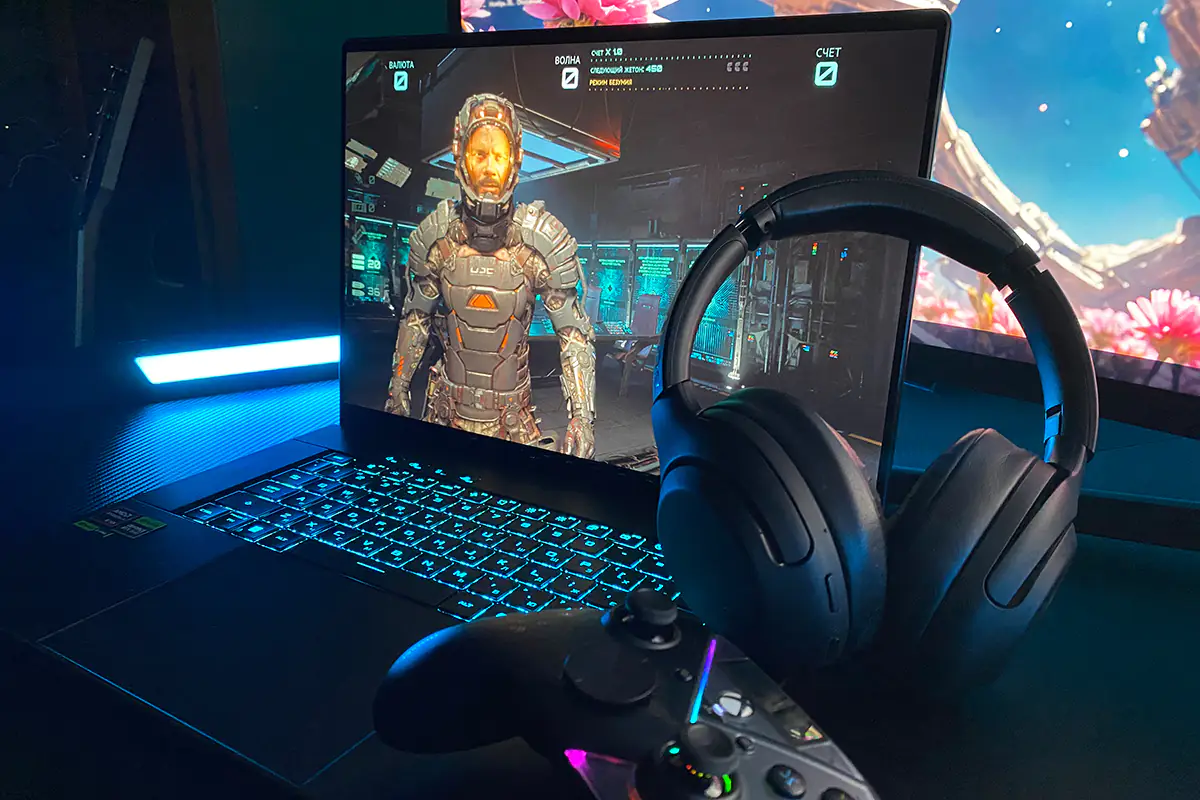
The sound settings remain unchanged from the previous model. All the features from before are still present here: AI noise cancellation for both the speakers and microphone, various modes in the Dolby Atmos settings, and a fully functional equalizer.
Camera and microphone
The camera and microphone setup also remains unchanged. The laptop features a Full HD camera with an IR sensor, supporting Windows Hello for secure login. For voice communication, it utilizes a three-microphone array. In the Armoury Crate settings, users can enable various microphone modes, including directional recording, enhanced stereo mode, 360° recording, multi-voice recording, and noise cancellation.
Network and wireless communications
The laptop is equipped with Wi-Fi 7 and Bluetooth 5.4 for network and wireless connections. By comparison, the previous model I reviewed featured Wi-Fi 6E and Bluetooth 5.3. During my testing, I encountered no connectivity issues. Internet speeds were consistently good, ping in games was stable, and wireless devices paired and connected quickly without any trouble.

Read also:
- ASUS ROG STRIX XG259CMS Gaming Monitor Review
- ASUS ROG Harpe Ace Extreme Wireless Gaming Mouse Review
Proprietary applications
Here, too, everything is unchanged. The laptop comes with 2 proprietary applications for advanced device settings – MyASUS and Armory Crate.
In MyASUS, you can: view information about the system status, register your device, view warranty information, perform simple error and malfunction diagnostics, update drivers, and contact technical support. Among the really useful features is the battery care mode. When it is activated, battery charging will be limited to 80%, which will help extend its service life.
Here, too, everything is unchanged. The laptop comes with 2 proprietary applications for advanced device settings – MyASUS and Armory Crate. In MyASUS, you can: view information about the system status, register your device, view warranty information, perform simple error and malfunction diagnostics, update drivers, and contact technical support. Among the really useful features is the battery care mode. When it is activated, battery charging will be limited to 80%, which will help extend its service life. Here you can assign an individual profile to each game. Individual profiles are created in Scenario Profiles. In Featured you can find various promotions, discounts, etc. And the News menu contains news from ASUS. In the User Center, you can create or log in to an existing ASUS account. The Settings menu contains the update center for the entire system and connected ASUS devices.
The “Device” menu contains settings for the laptop and all connected ASUS devices. In the “Memory” menu, you can view background processes and disable them if needed during gaming. The “GPU Power Saving” menu allows you to adjust memory allocation for the integrated GPU (iGPU) and switch between GPU modes (discrete graphics card). The “Customizable Hotkeys” menu lets you configure the M1-M4 quick access keys. The “Lighting” menu controls the keyboard backlighting, while the “Slash Lighting” menu adjusts the lighting for the strip on the laptop’s lid. The “Audio” menu includes settings for the microphone and speakers. In the “Resource Monitor” menu, you can analyze system performance and log the data. The “Modern Standby Assistant” menu simply allows you to toggle the standby assistant on or off.
Battery life
Like the previous model, this laptop comes with a 4-cell Li-ion battery rated at 90 Wh. It includes two power adapters: a standard 200W charger and a more compact 100W charger. The standard adapter is suitable for use at home, while the compact one is more portable for on-the-go use. Using the included 200W adapter, the laptop charges to 50% in about 30 minutes. A full charge takes just over an hour.

As for the battery life, I’ll just give you the results of PCMark 10 tests:
- 5 hours 12 minutes – everyday work
- 1 hour 4 minutes – gaming
All tests were conducted with the following laptop settings:
- system performance mode – Performance
- video card mode – Standard
- screen brightness – 75%
- screen refresh rate – 240 Hz
- keyboard backlight and Slash Lighting – on
The ROG Zephyrus G16 2024 (GA605WI-QR107X) offers fairly good battery life for a gaming laptop. While it won’t be able to support extended gaming sessions on battery alone, it is certainly capable of handling work tasks. Additionally, battery life can be further extended by turning off all lighting, lowering the brightness, reducing the refresh rate to 60Hz (or enabling dynamic refresh), and activating power-saving mode. With these adjustments, you can likely gain an extra hour of battery life without much trouble.
Conclusions
In summary, the ASUS ROG Zephyrus G16 2024 series can be considered a solid line of premium laptops. They are well-suited for both gaming and work. The design is stylish and high-end, with excellent build quality, a stunning OLED display and sound, strong performance, and decent battery life. As for the GA605WI-QR107X model specifically, it’s a well-executed device. However, to be honest, the price could be a bit more reasonable.
The key question is: which laptop is the better choice — the new AMD model or the previous Intel version with the same 4070 GPU? Let’s think this through. If your budget isn’t a concern and you’re looking for a more powerful laptop with a newer processor, then the GA605WI-QR107X is your best option. However, don’t expect a significant performance boost over the Intel model, especially in gaming. If you’re aiming to save some money, then the Intel-based model (GU605MI-QR064W) might be the better choice. After all, the difference in games between these two laptops is not that significant (in some games, it’s not even there). But the price difference – almost $452 / €435 – is quite significant. And the third option I see is to add $119 / €115 to the budget and consider the GU605MZ-QR120W model. Of course, it will have a simpler processor (Intel Core Ultra 7 155H), but it has a more powerful video card in the form of RTX 4080, which is more important for games.

Read also:
- Most Fascinating Robotics Innovations of 2024
- BLUETTI AC70 Portable Power Station Review: Compact Yet Powerful
- Biomimicry: How Nature Inspires Engineers to Innovate



